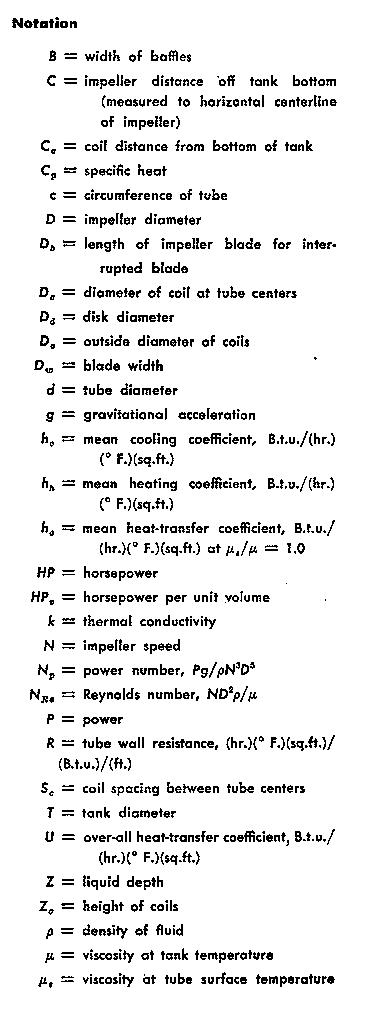Heat Transfer


Mixing can only affect (ho) the mixer side film coefficient.
The mixer only affects one of four parts of the overall heat transfer coefficient, and this overall heat transfer coefficient is only one of three items which will affect the total heat removed or added to a mixing vessel. Other variables, not controlled by mixing, can have a greater effect on heat transfer.
Doubling the mean temperature difference or doubling the heat transfer area would double the heat removed or added.
Also, everything being constant except the material of construction of a vessel, different heat transfer coefficients can be obtained. For instance d. which is the thickness of the tank
wall divided by the thermal conductivity of the material cf construction, can have a very large effect on the overall heat transfer coefficient. More heat transfer can be achieved in a stainles reactor than in a glassed steel reactor with the same mixer side coefficient.
There are many different methods of installing heat transfer area in tanks. Most of the research work in this field has been done with helical coils. As more and more heat transfer area is crowded into a vessel, the effectiveness of the heat transfer area decreases as shown below.
Vertical Tubes |
1.0 |
Helical Coils (Single) |
1.0 |
Helical Coils (Double)) |
0.85 |
Helical Coils
(Three or more) |
0.70 |
Plate Coils or Panel Coils |
0.73 |
Tank Jackets |
0.65 |
For the best film coefficient ( ho), when using helical coils, a spacing of approximately 2 diameters between centers should be used. This will allow proper flow between the coils so that maximum usage of the heat transfer area available will be achieved.
In scale-up, to-maintain the same film coefficient (ho), the horsepower per 1000 gallons Should remain approximately constant. With a jacketed vessel system, the heat transfer area per tank volume normally decreases with
scale-up. To maintain the same proportionate heat removal or heat addition per unit batch size, larger temperature differentials should be used, additional heat transfer area (as coils etc) should be considered, or other variables adjusted.
Approximately the same film coefficients are obtained at the same horsepower level and impeller diameter, whether the impeller is flat blade, axial flow impeller, or a propeller. Usually axial flow turbines are best for
heat transfer (as they are for other flow controlled jobs). When space is a problem flat blade turbines will help.
MIXER HEAT INPUT
In viscous mixing jobs, or those with high power levels, the impeller load puts heat into the batch. One horsepower hour is approximately 3000 BTU per hour. At 1 HP per 1000 gallons
impeller load, the temperature rise of a batch would be 0.2-0.3°F. and is proportionately higher at higher power levels.
In most heat transfer jobs, another mixing operation such as dissolving, solid suspension, blending, etc. will control the mixer selection. As long as the fluid regime is one of forced convection circulation; not natural convection, increasing the level of mixing will not economically provide a significant change
in the film coefficient,ho. Changes in heat transfer requirements will be more effective if made by a change other than variables in mixing.
increasing agitation by using a higher speed (N) or larger impeller diameter (D) will improve ho, however the increase is not significant.
|